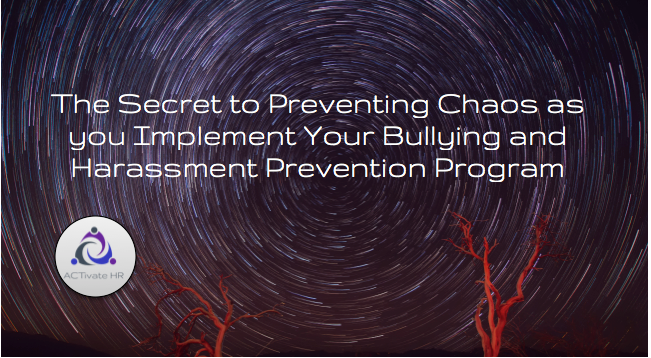Ready to implement a new harassment and bullying prevention program but worried about the chaos that could ensue? Then this post is for you!
Congratulations, you made it to the last step in setting yourself up for success with OHS Bill 30 and, ultimately, creating a psychologically safe and healthy workplace!
Now you have policies in place people are aware of and competent to enact. And we can’t forget the processes for identifying psychological hazards and then reporting and investigating them.
Implementing your harassment and bullying prevention program without chaos
The final step in the process is ensuring the integration of programs, policies, and communications. That way, the many people and departments who work with the policies interact efficiently. If you miss this step, confusion and chaos can result. Not to mention, the duplication of work, missed steps, and hard feelings between teams.
Many different departments will need to be involved in your harassment and bullying prevention program. The same goes for your programs to address bullying and harassment hazards and claims.
While this has always been the case, the addition of psychological health into safety legislation has created an increased potential for overlap in work and accountabilities. This often leads to confusion among individuals and departments. It also leads to things being missed if processes aren’t fully integrated and accountabilities clearly defined.
The main areas typically involved in psychological wellness/harassment/bullying prevention programs are:
- Health and Safety
- Human Resources
- Legal
- Learning, Development, and Training
- Wellness and Disability Management
- IT (if you have automated reporting systems)
Be sure to involve representatives from all these groups when you are building your policies, processes, communications, training, and any other aspects of your program. Prior to building or updating your program, do a quick internal scan of your company. Look for any other groups you should include. Now you have all the stakeholders involved.
Implementing your harassment and bullying prevention programs
Now, here’s a list of areas to consider to ensure all your processes and programs are integrated:
1. Clearly identify the accountabilities of each role as it relates to all areas of your programs and policies.
Pay particular attention to safety and HOUR roles. This is where potential overlap and confusion may manifest as employees start identifying and reporting psychological safety hazards and incidents.
2. Create a communication plan.
This plan ensures employees, as well as safety and HR professionals, are clear on the different reporting and investigation processes for physical and psychological hazards and injuries.
3. Ensure safety, HR, and corporate policies all share the same definitions, are clear on responsibilities, and give the same message.
Having a stand-alone policy that addresses workplace psychological safety as it relates to bullying and harassment that the other policies refer to is recommended.
4. Build and communicate internal processes.
These define where pass-offs happen between safety, human resources, and other departments such as disability management. Make sure the documentation is easy to find and reviewed regularly at the outset to ensure it meets everyone’s needs.
5. Ensure accountabilities for reporting, assessing, and monitoring psychological hazards and injuries are clear.
This is helpful for preventing the duplication of work between HR, safety, disability management, and any other areas involved.
6. Determine how confidentiality will be addressed when integrating these types of injuries and hazards into existing safety processes, tracking, and reporting.
Take extra caution not to disclose too much or breach confidences or privacy legislation.
7. Decide in advance when internal or external legal counsel should be involved or when external investigators will be used.
These should be guidelines and not hard and fast rules as these types of situations can be delicate and the severity can escalate quickly and unexpectedly.
8. Involve your training department.
This helps make sure the same messages and information are presented in all communication materials and training courses.
9. Update job descriptions and consider anticipated changes in workloads.
Properly assessing, identifying, and investigating forms of psychological injury takes time and resources.
A critical starting place
This list is a starting place for organizations when ensuring proper system-wide integration of harassment and bullying prevention programs. Get representatives from all affected areas in your company to participate in identifying other considerations specific to your organization.
This blog is the 7th in our 8 part series on preparing for Bill 30 and creating psychologically healthy and safe workplaces.
To read the series from the beginning and see the full checklist, click here. To jump to the previous article on effectively investigating bullying and harassment claims, click here. To read the last in the series, an article on what’s reasonable when it comes to managing employees, click here.
Can we help you implement a bullying prevention program?
Do you have questions about the content of this article? Or would you like help putting in place any of the items mentioned in this series? Please contact ACTivate HR at info@activatehr.ca.
We have decades of experience creating respectful workplaces and conducting workplace investigations into bullying, harassment, sexual harassment and other employee issues. We would love to partner with you!
Did you enjoy this post? Here are three more to read next:
Your Organization Received a Sexual Harassment Claim. Now What?
Are You a Bosshole? Or Do You Work for One?
Effectively Investigating Workplace Bullying and Harassment Hazards and Incidents
This article was originally published in 2018, but has been updated in 2020 just for you!

